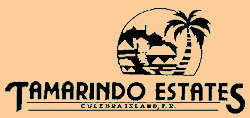Snorkeling in the Tamarindo Region - Click to enlarge
The Tamarindo Estates Reef
At Tamarindo Estates we have our own "private" reef,
protected from the outside world by the natural topography of the area. For walk-in snorkeling right off a beach, Tamarindo Estates is the right spot in Culebra. Once you cross over the other side of the shoreline reef, you can enjoy your swimming in shallow and pristine waters which are normally calm.
Another view of the Tamarindo Estates reef.Tamarindo and Flamenco Beaches
Tamarindo Bay beach is a nice swimming beach just a
seven minute walk from Tamarindo Estates
Beautiful Flamenco beach is famous for its large extensions of white sand. It is less than a 3 minute drive from Tamarindo Estates

Shells
at
Tamarindo*Beyond the fine snorkeling located adjacent to Tamarindo Estates, beyond the great sand beach tucked nearby at Flamenco and the delights of Zoni, is some of the finest shells to be found in the Caribbean. The turtle grass beds of the Luis Peņa Channel Marine Reserve on the Tamarindo region provide an excellent habitat for many different types of marine mollusks and bivalves.
As you snorkel over the turtle grass, the most common shell you will encounter is the Pink Conch. In either its juvenile or adult form, the conch is quickly recognized by its distinct shape and spire. The Pink Conch and other grass inhabitants like the Reticulated Seastar and Triton's Trumpet, are easily seen by the surface snorkelers. Other mollusks readily found include the Apple Murex, assorted conchs (milk and hawk winged) and several of the helmets including the Flame (or Princess) Helmet and the Cowrie Helmet.
A closer look at the grass bottom will reveal a variety of shells including Banded Tulips and Amber Pens. These animals, smaller than the conchs, are often hidden by the grass and reveal themselves only on close inspection.
The coral debris shoreline of much of the Tamarindo region is an excellent indicator of fine shells. Sand beaches may be delightful for swimming, but they provide few empty shells! A careful walk examining the shoreline coral will usually reveal a variety of fairly large shells including:
West lndian Fighting Conch
Florida Fighting Conch
Banded Tulip
True Tulip
Netted Olives
West lndian Top ShellGiven the pounding that the ocean provides, it takes a substantial shell, like those mentioned above, to make the shore undamaged. A beautiful shell that is often only found in bits and pieces is the Atlantic Partridge Tun, It can be recognized by its pale off-white color, light brown spots and cower-like slit.
Another great find is the Angular Triton, the classic shell of the Caribbean.
If you take time to examine the beach you'll soon note a pattern as to where shells congregate. Small shells work their way to the center section of the beach. Sometimes you can pick up a handful of shells that have simply swirled together in this region. Among the ones typically found are:
Coffee Bean Trivia
Flamingo Tongues
Assorted Nerites
Dove Shells
Brown Cowries
Assorted Periwinkles
Sundials
Limpets
Chitons
Baby Ears
Lions Paw Scallop
Sentis Scallop
Caribbean Jewel BoxGood reference books on shells:
The Audubon Society Field Guide to North American Seashells (Covers the Caribbean)
Simon & Schuster's Guide to Shells by H. S. Feinberg
* The article on shelling was graciously contributed by a Vermont family who spent a vacation at Tamarindo Estates.
![]()

P. O. Box 313, Culebra, P. R.
00775, Tel. (787) 742-3343
![]()
 |
 |
 |
 |
 |
 |
 |
 |
 |
 |
![]()